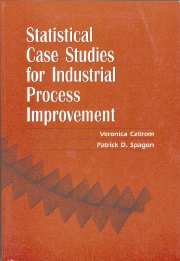Statistical Case Studies for Industrial Process Improvement
American industry is becoming more aware of the importance of applying statistical methods to improve its competitive edge in the world market. Examples of real industrial applications can serve as a major motivator for industries that want to increase their use of statistical methods.
This book contains a broad selection of case studies written by professionals in the semiconductor industry that illustrate the use of statistical methods to improve manufacturing processes. These case studies offer engineers, scientists, technicians, and managers numerous examples of best-in-class practices by their peers. Because of the universal nature of statistical applications, the methods described here can be applied to a wide range of industries, including the chemical, biotechnology, automotive, steel, plastics, textile, and food industries.
Reviews & endorsements
'A wonderful collection of superbly documented industrial statistical experiences … This book will inspire experienced researchers. Beginners, in addition, will learn a good deal about statistical techniques for industrial problem solving.' Lloyd S. Nelson, Journal of Quality Technology
' … A good investment for those who are directly involved in the study or application of statistical methods.' George G. R. Maharage, Manufacturing Engineer
Product details
January 1997Paperback
9780898713947
542 pages
250 × 180 × 20 mm
0.622kg
This item is not supplied by Cambridge University Press in your region. Please contact Soc for Industrial null Mathematics for availability.
Table of Contents
- Foreword, Preface, Acknowledgments, Introduction, Facts About SEMATECH, SEMATECH Qualification Plan, Part One: GAUGE STUDIES, Chapter 1: Introduction to Gauge Studies, Chapter 2: Prometrix RS35e Gauge Study in Five Two-Level Factors and One Three-Level Factor,Chapter 3: Calibration of an FTIR Spectrometer for Measuring Carbon, Chapter 4: Revelation of a Microbalance Warm-Up Effect, Chapter 5: GRR Methodology for Destructive Testing and Quantitative Assessment of Gauge Capability For One-Side Specifications, Part Two: PASSIVE DATA COLLECTION, Chapter 6: Introduction to Passive Data Collection, Chapter 7: Understanding the Nature of Variability in a Dry Etch Process, Chapter 8: Virgin Versus Recycled Wafers for Furnace Qualification: Is the Expense Justified?, Chapter 9: Identifying Sources of Variation in a Wafer Planarization Process, Chapter 10: Factors Which Affect the Number of Aerosol Particles Released by Clean Room Operators, Chapter 11: A Skip-Lot Sampling Plan Based on Variance Components for Photolithographic Registration Measurements, Chapter 12: Sampling to Meet a Variance Specification: Clean Room Qualification, Chapter 13: Snapshot: A Plot Showing Progress Through a Device Development Laboratory, Part Three: DESIGN OF EXPERIMENTS, Chapter 14: Introduction To Design Of Experiments, Chapter 15: Elimination of TiN Peeling During Exposure to CVD Tungsten Deposition Process Using Designed Experiments, Chapter 16: Modeling a Uniformity Bulls-Eye Inversion, Chapter 17: Using Fewer Wafers to Resolve Confounding in Screening Experiments, Chapter 18: Planarization by Chemical Mechanical Polishing: A Rate and Uniformity Study, Chapter 19: Use of Experimental Design to Optimize a Process for Etching Polycrystalline Silicon Gates, Chapter 20: Optimization of a Wafer Stepper Alignment System Using Robust Design, Chapter 21: Application of Semi-Empirical Model Building to the RTCVD of Polysilicon,Part Four: STATISTICAL PROCESS CONTROL, Chapter 22: Introduction to Statistical Process Control, Chapter 23: Removing Drift Effects When Calculating Control Limits, Chapter 24: Implementation of a Statistical Process Control Capability Strategy in the Manufacture of Raw Printed Circuit Boards for Surface Mount Technology, Chapter 25: Obtaining and Using Statistical Process Control Limits in the Semiconductor Industry, Part Five: EQUIPMENT RELIABILITY, Chapter 26: Introduction to Equipment Reliability, Chapter 27: Marathon Report for a Photolithography Exposure Tool,Chapter 28: Experimentation for Equipment Reliability Improvement, Chapter 29: How to Determine Component-Based Preventive Maintenance Plans, Part Six: COMPREHENSIVE CASE STUDY, Chapter 30: Introduction to Comprehensive Case Study, Chapter 31: Characterization of a Vertical Furnace Chemical Vapor Deposition (CVD) Silicon Nitride Process, Appendix: Introduction to Integrated Circuit Manufacturing, Glossary of Selected Statistical Terms, Index of Selected Statistical Terms.




